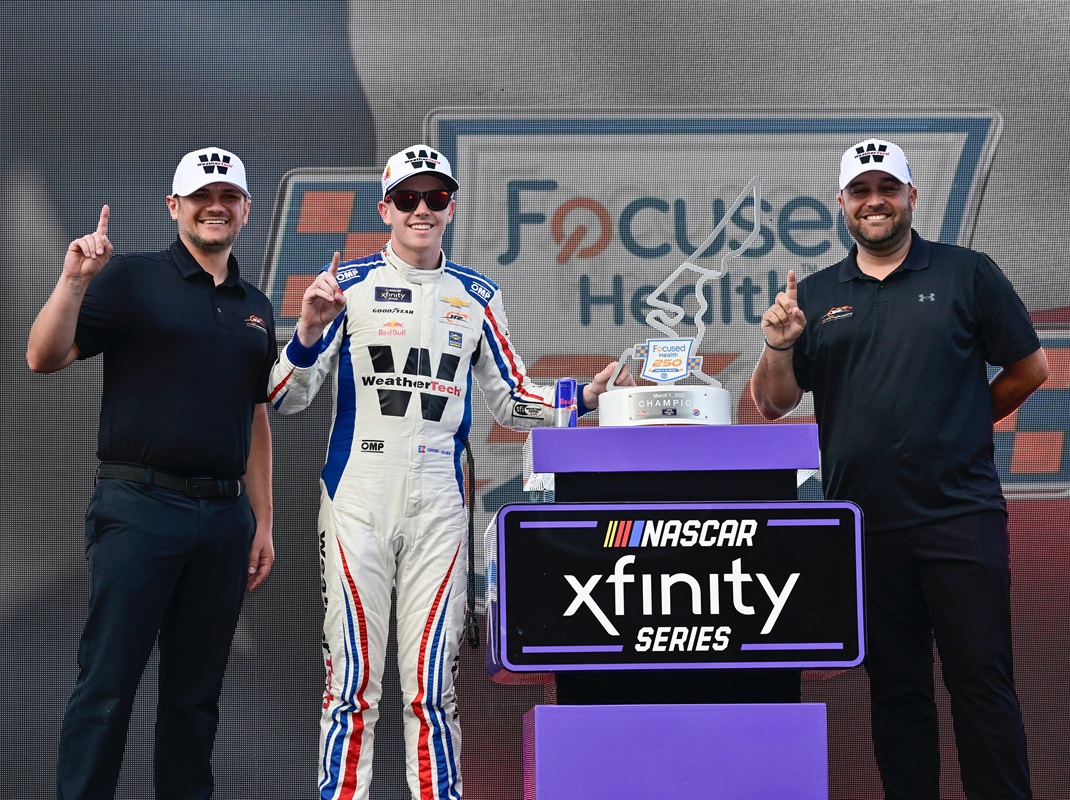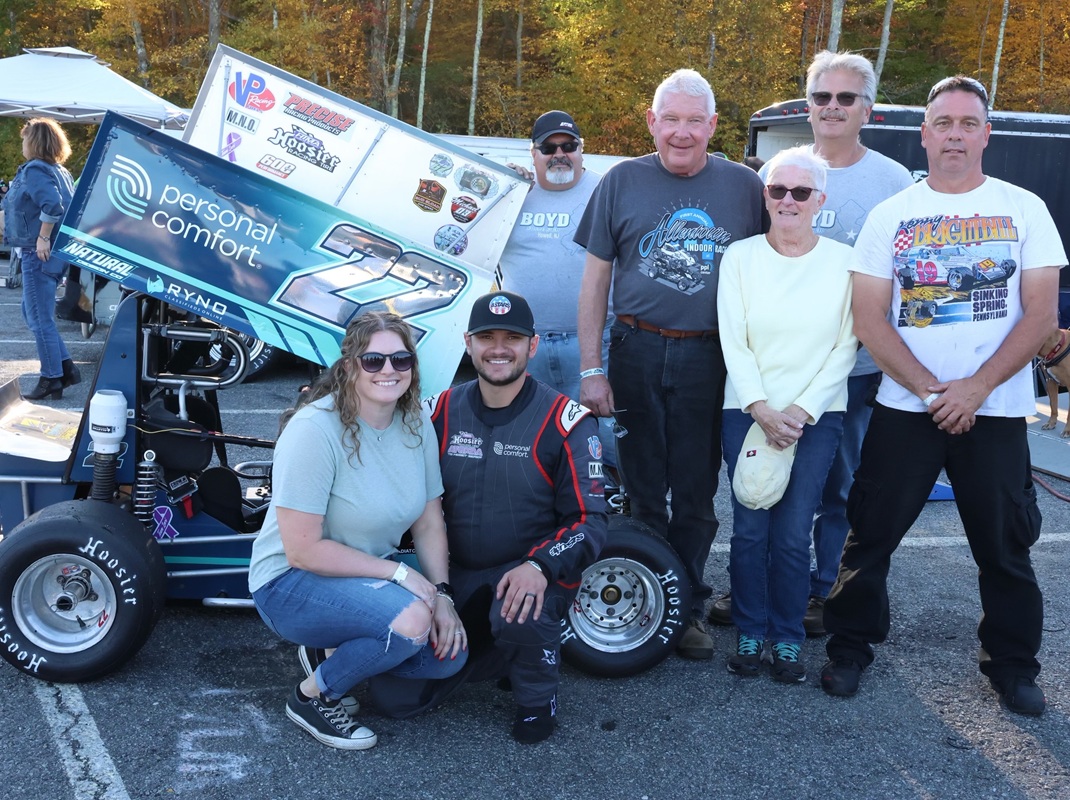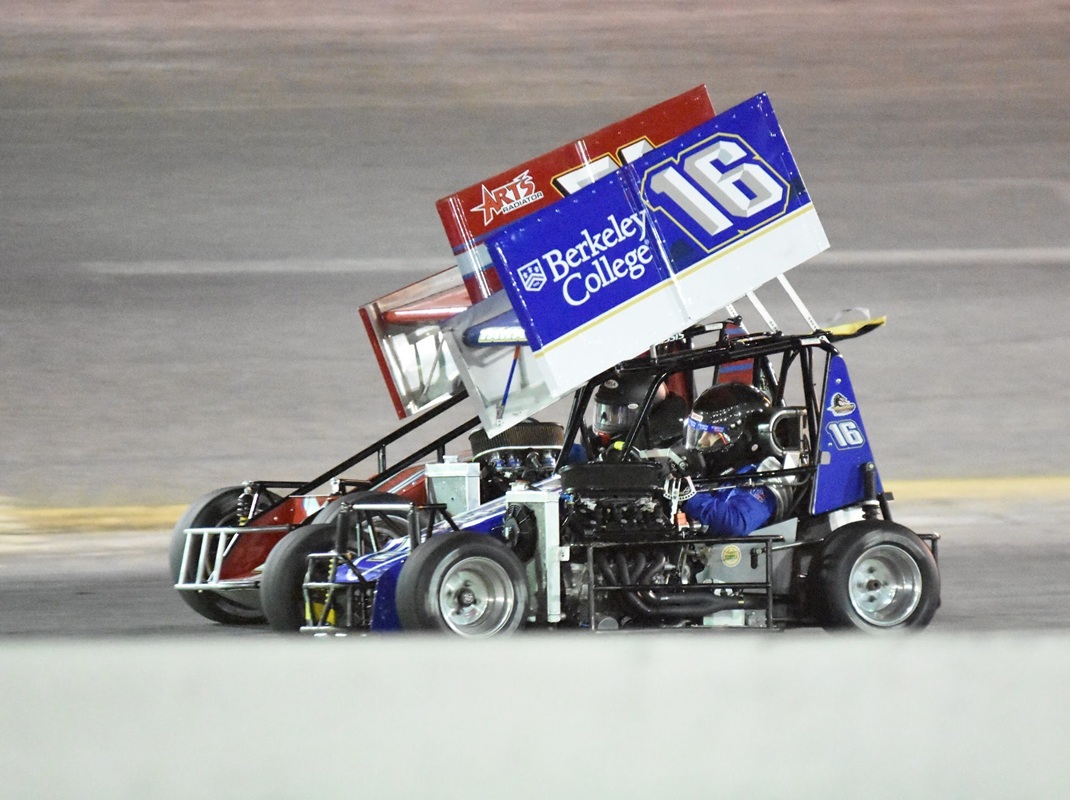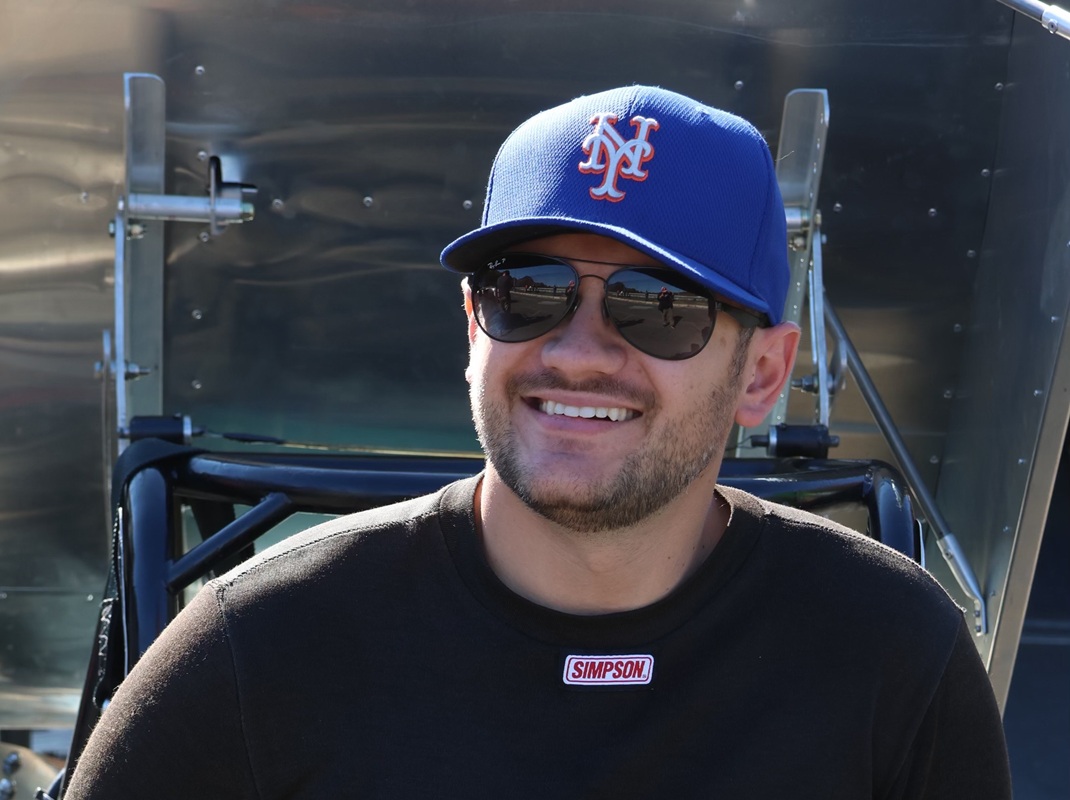Lightning In A Bottle: Kyle Taraska’s Unique Racing Journey

From left: Kyle Taraska, Connor Zilisch, and Josh Williams in victory lane at Circuit of the Americas in March. (Nigel Kinrade/NKP photo)
WOODBRIDGE, N.J. – Many consider dreams to be fantasies beyond the reach of reality, typically only attainable through miraculous happenstance or luck.
For Kyle Taraska, the culmination of a mutual brotherhood – blended with unrelenting work ethic and an unwavering passion for racing – led to the opportunity of a lifetime to realize his childhood aspirations of working in NASCAR.
Taraska may not be a name familiar to most, but there’s a reason the 31-year-old from Woodbridge, N.J., leaves a lasting impression on seemingly anyone fortunate enough to cross paths with him. His unconventional journey to racing, spawned by his immense dedication to his craft and his natural ability to form meaningful connections, makes for an inspiring story.
From working his way into racing three-quarter midgets, to now getting the opportunity to spot NASCAR national series races for Shane van Gisbergen and Connor Zilisch with his best friend at Trackhouse Racing, Taraska has built his journey from the ground up.
“I would say the coolest job in the world is being a race car driver, because you’re out there and you’re doing it,” Taraska said. “And I would say the second coolest job in the world is being a spotter, because you get paid to have the best seat in the house to watch a race and be a part of it, and provide valuable information, while competing at a high level.”
Before getting to know the man underneath the helmet or on the other end of the headset, it’s equally as important to know just how Taraska made it to the NASCAR ranks, and who made it possible.
That’s where championship-winning spotter Josh Williams comes into play.
Not only was Williams a groomsman in Taraska’s wedding to his high school sweetheart of 14 years, Megan, Taraska served as Williams’ best man at his wedding earlier this year to racer Brittney Zamora.
While their friendship dates back 15 years, where the two were paired in the same competitive class and servers in iRacing, the event that changed Taraska’s life and truly formed their brotherhood occurred in October 2013 – and made it into his best man speech.
The pair participated in a 500-mile race in conjunction with the NASCAR Cup Series fall race at Charlotte (N.C.) Motor Speedway. Having raced against each other about three to four times per week, they developed respect for each other.
Throughout the event, they worked together as best as they could, cutting each other breaks and running well within the top 10.
Near the end of the race, someone cut Williams off, to which he retaliated. The veteran spotter was able to finish the race, whereas Taraska was collected in the wreck, leaving him livid and feeling like he wasted three hours of his life.
“What I didn’t realize was that was probably the most important three hours of my life, because after that, Josh and I got connected,” Taraska said. “He apologized and that was when this whole friendship really started.
“ I think for Josh and I, we were just able to have a great relationship, because we had the same interests. I was going to six or eight Cup races a year, so it was easy to get together with him and hang out over the weekends. We both looked forward to that and it was like having this racing connection that we manifested through iRacing, but our time to hang out was at the racetrack.”
Ever since then, Taraska made it a point to fly down to Charlotte to hang out, while Williams would occasionally travel to New Jersey, where the two of them and their wives would make trips to New York City or New York Mets games.
“He's my big brother,” Taraska said of Williams. “I've always admired him. Between him and my wife, they've always been the two that really just help me keep my head on straight. Josh has always been a big influence. And listen, he's stubborn, but he's usually right. He’s just always been that guy for me that I feel like I could trust with my life.
“I would never question a situation that Josh Williams got me into, and for him to ask me to help him with spotting, obviously getting the approvals from the teams and everything else, that was a big moment for me. I think that was a big moment for our relationship as well.”
The feeling is mutual for Williams, who also unknowingly promoted their brother dynamic.
“He’s just very trustworthy and very passionate about racing,” Williams said. “He’s always trying to learn every aspect of it. It's his number one love, the thing he likes doing the most and talking about the most. We kind of just bonded through that.
“He’s just like my little brother. He’s always been there through the good and bad, and I feel like I have for him, too. The longer time goes, the closer we get. He’s somebody I could always talk to about anything, whether it's good or bad, and pick on at any moment I want to as well. He turned into one of my closest friends just because he is always there.”
As alluded to by Taraska, it was Williams who put his name on the line and went to bat for his best friend when Spire Motorsports needed an additional spotter at Watkins Glen (N.Y.) Int’l in 2024.
In addition to being someone trustworthy with a passion for racing, there’s a history associated with veteran spotter’s endorsement.
Taraska’s love for racing began at seven years old, when his father took him to his first NASCAR race at Dover Motor Speedway – a tradition they’ve kept going since 2001. From there, they would frequent local tracks like Wall Stadium, New Egypt Speedway and Bridgeport Speedway over the weekends.
Taraska had what he called a “normal childhood,” playing basketball and little league baseball, but he always found himself at the race track.
But there was always a desire for Taraska to race, but he never had the funding to do it early in his life, like most racers. In fact, he didn’t even strap into a race car until 2014, when he partook in the Green Flag Racing Experience at Wall, while working as game-day event staff for the New York Yankees AA-affiliate Somerset Patriots.
The ballpark hosted a racing night and the program was one of the sponsors. Seeing an opportunity to get on track via a random draw contest, Taraska took his shot, writing out eloquently how he wanted to make racing a career.
Lo and behold, that’s how he got to turn his first laps in a three-quarter midget.
After getting his first taste for speed, Taraska volunteered with the racing program for two years, and in turn they let him run laps at Wall. Eventually, he got in contact with a car owner in the American Three Quarter Midget Racing Ass’n (ATQMRA), where he finally got turned loose to put down laps without restrictions.

Kyle Taraska (second from left) and his family celebrate the 2022 ATQMRA championship. (E.J. O'Rourke photo)
The first official race he ran was at the end of the ATQMRA season in September 2016. He then contested a handful of races in 2017, so he was eligible to keep his rookie status going into 2018.
Taraska went on to win 2018 ATQMRA rookie-of-the-year, scoring nine feature wins and counting at multiple tracks and counting. His crowning achievements thus far have been his Turkey Derby victory in 2020 and his ATQMRA championship in 2022.
“For me to basically come from nothing from a racing standpoint, you know, I didn’t grow up racing quarter midgets, didn’t grow up in a house with a mechanical background or anything like that … I really just put my head down and kind of figured out a way to make it work,” Taraska said. “My way of doing it is very unique to me, and I don't know if it’s possible in 2025 to recreate this story and make it successful.
“It’s almost like I caught that lightning in a bottle.”
Taraska attributes his ability to find on-track success to his relationship with Leonard Boyd, one of the most respected racers in the Northeast region. In fact, he sports the No. 22 on his three-quarter midget in honor of Boyd.
Boyd saw a bulk of his own success, also racing three quarter midgets, from the 1970s through the 1990s, with his most notable victories being the 1990 Turkey Derby and 1993 Race of Champions at Flemington Speedway.
While Boyd doesn’t own Taraska’s car, it stays in his shop, where they spend countless hours together. The 31-year-old considers his mentor the hardest working man he knows, and although he doesn’t feel he has his mechanical ability, he tries to emulate it as much as possible, modeling his work ethic after him.
Earl Krause, columnist for Area Auto Racing News and announcer at Wall Stadium since 1980, knew there was something different about Taraska from the minute he met him in the pit area in 2013. He was immediately struck by Taraska’s meticulous way of operating and how articulate he was.
Additionally, Taraska would take the time and initiative to make notes on every driver in the field and present them to the announcing staff before each event. Krause also notes it’s no surprise the 31-year-old is such a popular driver among the local fans, with the way he holds himself and how makes it a point to speak with any individual who wants to know more about him or racing.
“He’s a very fine racer, and one of the reasons I believe this is because he's very detail oriented,” Krause said. “He’s very detailed with the statistics that he keeps on his race car, and the setups and his equipment are always immaculate. To me, that’s very important, and that translates to the on-track to performance. Any good race car driver on any level, it’s how they prepare for the car and also how they prepare themselves.
“I’ve often noticed, as far as racing goes, Kyle is always mentally prepared. You watch him pre-race, he’s observing what the other racers are doing, track conditions, taking the car out for pre-race warmups, coming back and making adjustments – he’s always ready.”
Another quality that stands out to Krause about Taraska’s racing is how he conducts himself both on and off the track – with professionalism and respect.
“One of the things that also impressed me about Kyle is he’s a young guy who is looking to advance his career in racing and in business, but he’s not the kind of guy who will advance them by pushing somebody out of the way,” Krause said. “He'll work at it the way it should be done – the old-fashioned way.
“Even on the racetrack, he’s never going to push somebody out of the way to win. He wants to win the right way, and when he wins – and he’s won a lot – he’s done it the right way, and that’s why he’s a very popular driver with the fans, too. He stays true to himself and his morals and whatnot.”
Having the skills to race is one thing, but anyone involved in motorsports knows it’s impossible to have a career in the industry without funding. That’s where Taraska’s bachelor’s degree in business administration from Berkeley (N.Y.) College comes in handy.
Taraska, who maintained a 4.0 GPA during his college tenure, sought Berkeley to fund the start of his racing venture. He got the idea from William Byron, who was and still is sponsored by his alma mater Liberty University.

Kyle Taraska (16) en route to his first ATQMRA win in 2018 at Wall Stadium in New Jersey, with sponsorship from Berkeley College. (Sean Case photo)
Taraska went to the Dean of Berkeley, selling him on a pitch seeking sponsorship, which would help support a student and promote the school. He landed a meeting with the Dean and Head of Marketing, created a PowerPoint proposal and made his pitch dressed in a suit and tie, which led to a two-year sponsorship. He also landed a two-year deal with the popular fast food chain Chick-fil-A, a company which he worked at for a decade, before leaving at a General Manager position.
Had Taraska not gotten those sponsorships from Berkeley and Chick-fil-A, he believes he wouldn’t have been able to continue racing. Landing those deals was a true testament to his determination and witty business mind.
Fast-forwarding to the present day, it’s likely easier now to see why Taraska got both the endorsement from Williams, as well as the stamp of approval from Spire in his first spotting gig at Watkins Glen in 2024.
It also helped tremendously that Taraska helped guide Zane Smith to a fifth-place finish in his first time spotting in the Cup Series.
“I just felt like I belonged,” Taraska said. “The true-tell point for me was on one of the last restarts, Zane entered the esses four-wide. I cleared him, and I was confident in my call, but there’s always that thought in the back of your mind, ‘If I clear him and if he isn’t clear, and if this whole track gets blocked on this restart, it’s going to be on me. Like, that’s it. I’m a one-and-done here.’
“But when I made that call, obviously it all worked out well.”
In addition to having racing experience himself, Taraska wasn’t going into a spotting role completely blind. He’d spotted at Wall before and even done race directing for the ATQMRA. That, in addition to listening to Williams spot essentially every single race since they’ve been friends, was key.
Furthermore, Taraska’s innate initiative to be a student of whatever endeavor he’s embarking on, as well as working closely with Williams, has allowed him to hone his craft and earn him even more opportunities with Trackhouse Racing this year.
“He’s a sponge for the sport, because he wants to be better at it and he wants to understand everything,” Williams said of Taraska. “He listens to me every week, so even the weeks he isn’t spotting, I feel like we kind of debrief on things that I did, or what could have gone better or worse. He’s kind of the punching bag after the race if I need to talk to somebody about how it went.
“He’s probably the first call I make to just debrief about the weekend.”

Kyle Taraska (E.J. O'Rourke photo)
This season, Williams made the move from Spire to Trackhouse, where he now spots for Shane van Gisebergen. Given how successful and well-received Taraska was by his peers in his first spotting attempt, he remains the No. 88 team’s third spotter when NASCAR goes to road courses.
Taraska and Williams shared a full-circle moment in their friendship at Circuit of the Americas earlier this year in the NASCAR Xfinity Series, when they made the trip to victory lane together with Connor Zilisch.
“There are a lot of people in the world that try to have success in racing, whether it be at the national level or the local level, and a lot of people don’t find it,” Taraska said. “I’ve been fortunate enough to win races as a driver. I’ve been fortunate enough now to win and stand in victory lane for a NASCAR national series win, which is as close as I’ll ever get.
“One of the most satisfying moments for me was being able to stand in victory lane with Josh. The other special part, too … for (Zilisch) to acknowledge my name on the radio and give me that thumbs up [of approval], that was very, very special.”
Next up for Taraska, he will be back on the spotter stand at Autodromo Hermanos Rodriguez in Mexico City for both Zilisch in Xfinity and van Gisbergen in Cup. He will also be on the headset for both drivers at Pennsylvania’s Pocono Raceway and Watkins Glen, in addition to working with Layne Riggs in the NASCAR Craftsman Truck Series at The Glen and Lime Rock Park in Connecticut.
As for what the future holds for Taraska long-term in NASCAR, he’s currently dedicated to being a full-time husband and dog dad, on top of racing in the ATQMRA and working as a corporate recruiter for Safelite. But he certainly wouldn’t shy away from any potential new opportunities.
“I would absolutely love the opportunity to work in the industry one day,” Taraska said. “But for right now, it's just been really cool to be a part of Trackhouse and basically be able to work with your best friend. Something like this is pretty special.”
“I mean the sky’s the limit for Kyle,” Williams added. “He could do whatever he wants to if he just sticks with it. His passion for the sport, I don’t feel like it's going to go away, and I feel like that’s the main thing you need to keep building on in anything you do in the sport. I think if he wants to do it, he could probably make it into whatever he wants to do long-term.”


